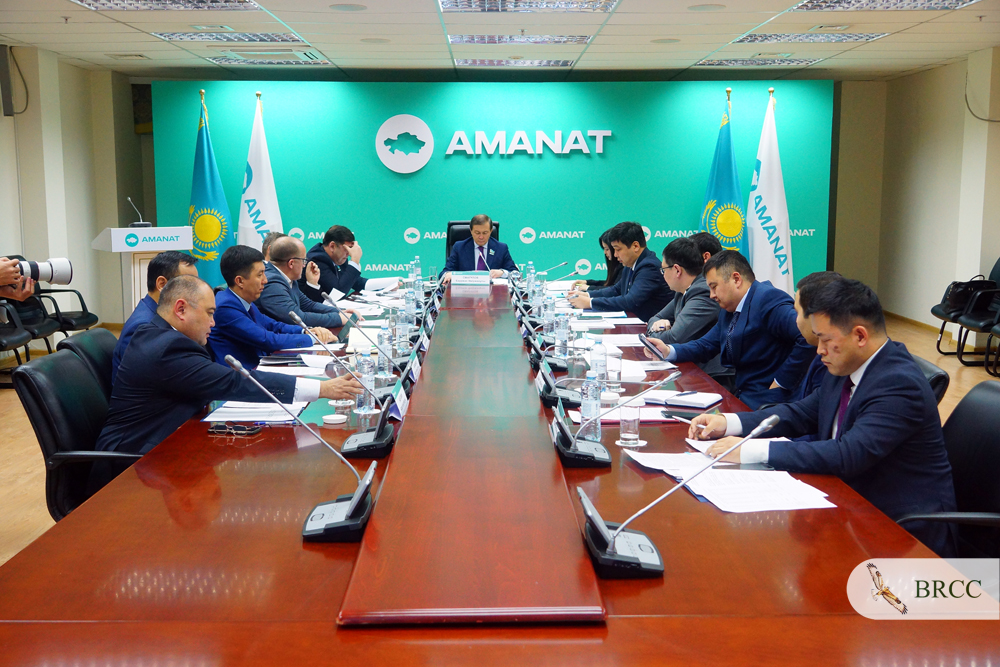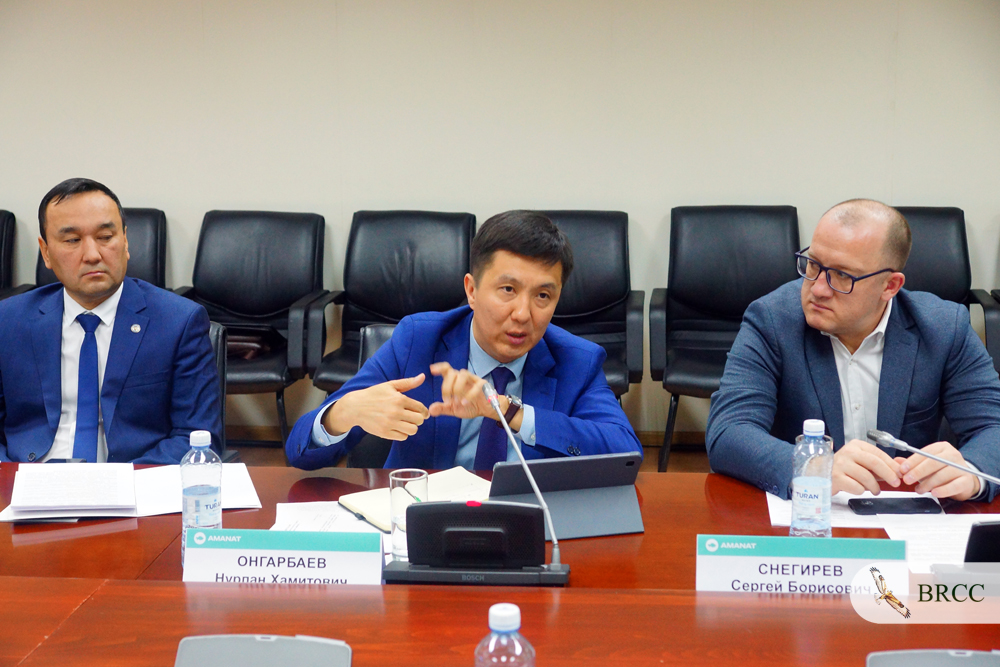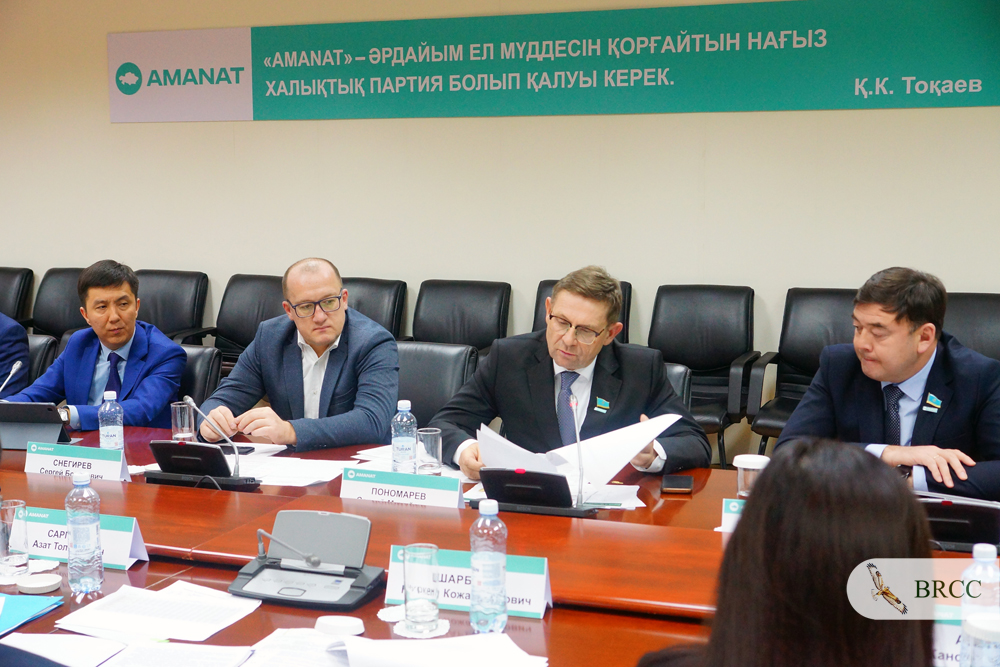Representatives of the Ecological Council of the AMANAT party expressed their readiness to support BRCC proposals for the protection of rare birds in Kazakhstan
November 7 in the Central Office of the party AMANAT held a meeting of the Ecological Council, which discussed key issues of biodiversity conservation in Kazakhstan. The Ecological Council under the party AMANAT is a consultative and advisory body that forms proposals for improving the legislation of the Republic of Kazakhstan in the field of ecology and promoting the creation of conditions for the implementation of environmental policy of the state. In addition to the Council participants, the meeting was also attended by representatives of the Presidential Administration, the KNB Border Service, the Ministry of Ecology and Natural Resources, the Ministry of Energy, the Ministry of Transportation, the Ministry of Internal Affairs, and the Anti-Corruption Agency.
The meeting of the Ecological Council addressed the issues of financing targeted programs for certain rare species of animals, including the conservation of the saiga population, as well as bird conservation. Presentations were made by Nurken Sharbiev, Vice-Minister of Ecology and Natural Resources, Talgat Kerteshev, Professor of KazNAIU, and Nurlan Ongarbayev, Executive Director of the BRCC Public Foundation.
In his speech, consisting of three presentations, BRCC Executive Director Nurlan Ongarbayev reported on the main threats to rare bird species associated with the power industry and smuggling in Kazakhstan.
The first presentation focused on the risks associated with possible negative impacts on birds as a result of the active but environmentally uncontrolled development of wind power in the country. Nurlan Ongarbayev, referring to IUCN data on bird mortality at wind farms in the USA, Canada and South Africa, noted that a similar threat exists in Kazakhstan. He emphasized that many wind energy projects in the country do not take into account biodiversity conservation aspects when choosing the location of construction and operation of their facilities, which can lead to serious consequences for biodiversity.
In this regard, the BRCC Executive Director asked the Ministry of Ecology and Natural Resources to strengthen environmental control in the design of wind power facilities, taking into account the migration of birds and bats, as well as to consider measures to reduce potential damage to wildlife for already commissioned wind power plants. In conclusion, he emphasized the need to finalize the regulation of the problems voiced and requested the support of the Ecological Council representatives in considering and adopting the submitted proposals.
The second part of the report was devoted to the problem of mass death of rare birds on overhead power lines (OPL) and the need for its legislative solution. During the report it was noted that according to the results of studies in Kazakhstan, from 35 to 73 thousand red-listed birds die annually from electric shock on overhead power lines. Due to the large length of overhead power lines and the concentration of birds in places far from populated areas, this problem is “invisible” to the public and many regulatory agencies. Given the large territory of the country, field control of bird deaths on overhead power lines after their commissioning is an impossible task. In this regard, BRCC proposes a legislative solution to this issue by formalizing the term “electro-bird-hazardous structure”, establishing restrictions on the design and construction of such structures, and phasing in a ban on the operation of overhead power lines that are not equipped with bird protection devices. Despite the support of the proposed legislative amendments by the Ministry of Ecology and Natural Resources, there are many other government agencies that could reject or suspend the proposed legislative changes. Ongarbayev Nurlan appealed to AMANAT deputies and members of the Environmental Council for support on this issue and met with a preliminary response and understanding of the problem.
The final part of the report dealt with the problem of declining numbers of Saker Falcons, the main cause of which is the illegal catching and smuggling of these birds for falconry. Despite the fact that the cause of the decline in the population of the endangered Saker Falcon is known, not a single criminal case has been opened for corruption since Kazakhstan's independence, without which poaching activities on such a scale would be impossible. The presentation also pointed out the need to develop a strong government position on the protection of the Saker Falcon, both nationally and internationally, as well as the importance of developing an interagency action plan to combat its smuggling. The report concluded with the statement that the restoration of the Saker Falcon population will improve the image of the Republic of Kazakhstan in the international arena, as well as expand opportunities for the development of the tourism industry of the country.
The report of the Executive Director of the BRCC Foundation provoked a lively discussion among the deputies and representatives of state bodies present. Members of the Ecological Council of the AMANAT party expressed interest in the problems raised, asking clarifying questions and expressing the possibility to assist in the proposed initiatives. Chairman of the Ecological Council Baurzhan Smagulov and Deputy of the Majilis of the Parliament of Kazakhstan Sergey Ponomarev reported their agreement with the theses on the relevance of the problem of conservation of rare birds of Kazakhstan and indicated their readiness for further work to address the identified problems aimed at preserving biodiversity in Kazakhstan.
The AMANAT Ecological Council's support for the recommendations developed by BRCC could be an important step towards achieving conservation goals for rare bird species in Kazakhstan.



